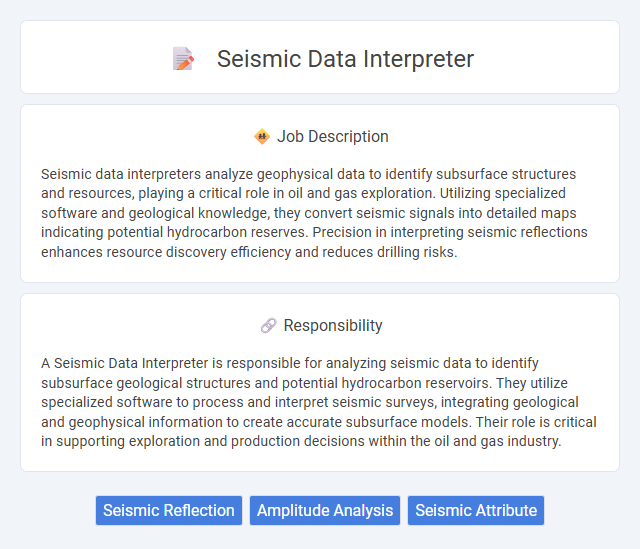
Seismic data interpreters analyze geophysical data to identify subsurface structures and resources, playing a critical role in oil and gas exploration. Utilizing specialized software and geological knowledge, they convert seismic signals into detailed maps indicating potential hydrocarbon reserves. Precision in interpreting seismic reflections enhances resource discovery efficiency and reduces drilling risks.
Individuals with strong analytical skills, attention to detail, and a passion for geology are likely to be well-suited for a seismic data interpreter job. Those comfortable working with complex software and interpreting intricate seismic patterns may find this role engaging and rewarding. People who prefer repetitive tasks or struggle with technical data analysis might find this position challenging or less satisfying.
Qualification
A Seismic Data Interpreter typically requires a degree in geophysics, geology, or petroleum engineering, combined with strong analytical skills to evaluate seismic data for oil and gas exploration. Proficiency in seismic interpretation software such as Petrel, Kingdom, or OpendTect is essential for accurate analysis and mapping of subsurface structures. Relevant industry certifications and experience in geophysical data processing enhance job performance and career prospects in the energy sector.
Responsibility
A Seismic Data Interpreter is responsible for analyzing seismic data to identify subsurface geological structures and potential hydrocarbon reservoirs. They utilize specialized software to process and interpret seismic surveys, integrating geological and geophysical information to create accurate subsurface models. Their role is critical in supporting exploration and production decisions within the oil and gas industry.
Benefit
Seismic data interpreters likely benefit from high demand in the energy sector, providing job stability and competitive salaries. Their expertise in analyzing subsurface geological formations could enable contributions to more efficient resource exploration and environmental safety. Opportunities for career advancement and skill development may also be common in this specialized field.
Challenge
Seismic data interpreter roles likely involve the challenge of accurately analyzing complex subsurface geological data to predict oil and gas reservoirs. Strong analytical skills and attention to detail are probably essential to differentiate meaningful signals from noise. The job may demand continuous adaptation to evolving technologies and interpretation techniques in a high-stakes environment.
Career Advancement
A Seismic Data Interpreter analyzes subsurface geological formations by evaluating seismic data to aid in identifying oil, gas, and mineral deposits, driving efficient resource extraction. Career advancement typically involves progressing from junior interpreter roles to senior-level positions such as Lead Geophysicist or Exploration Manager, where leadership in project planning and data integration is key. Continuous skill development in advanced seismic software, machine learning applications, and cross-disciplinary collaboration enhances opportunities for promotion and higher salary prospects.
Key Terms
Seismic Reflection
Seismic data interpreters specializing in seismic reflection analyze subsurface geological formations by interpreting reflected seismic waves recorded during surveys. They identify key stratigraphic layers, faults, and hydrocarbon reservoirs using advanced software tools to enhance exploration accuracy. Expertise in seismic reflection techniques enables precise mapping of subsurface structures crucial for oil and gas exploration and geotechnical projects.
Amplitude Analysis
Amplitude analysis in seismic data interpretation involves evaluating the strength and variation of seismic wave reflections to identify subsurface features such as hydrocarbon reservoirs and lithological changes. Skilled interpreters utilize advanced software tools to analyze amplitude anomalies, AVO (Amplitude Versus Offset) responses, and amplitude attributes, enhancing the accuracy of reservoir characterization. Expertise in amplitude analysis significantly improves exploration success by providing critical insights into rock properties and fluid content.
Seismic Attribute
Seismic data interpreters analyze seismic attributes such as amplitude, frequency, phase, and coherence to identify subsurface geological features and hydrocarbon reservoirs. Mastery of attribute extraction techniques and software tools enables precise mapping of faults, fractures, and stratigraphic traps. Proficient interpretation of seismic attributes enhances reservoir characterization, reducing exploration risk and optimizing production strategies.
 kuljobs.com
kuljobs.com